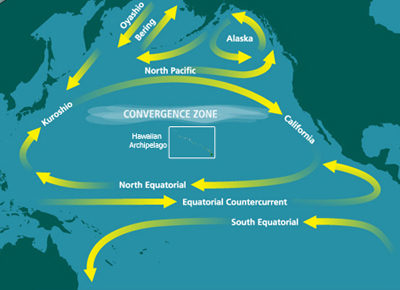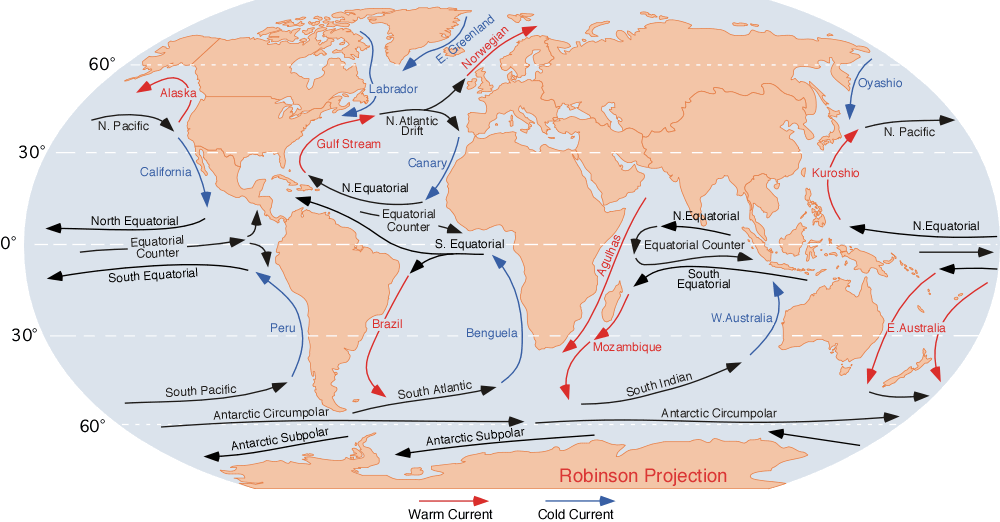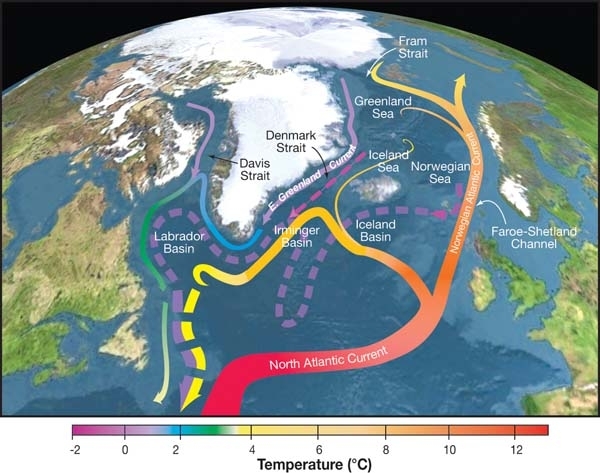|
North Equatorial Current
The North Equatorial Current (NEC) is a westward wind-driven current mostly located near the equator, but the location varies from different oceans. The NEC in the Pacific and the Atlantic is about 5°-20°N, while the NEC in the Indian Ocean is very close to the equator. It ranges from the sea surface down to 400 m in the western Pacific. The NEC is driven by the north-hemisphere easterly trade wind. In couple with NEC, there is another current called South Equatorial Current ( SEC), generated by the easterly trade wind in the southern hemisphere. Despite the well-coupled name of the two equatorial currents, the distribution of the NEC and the SEC is not in symmetry at the equator, but slightly northward to the equator. This asymmetric distribution is aligned to the location of the Intertropical Convergence Zone (ITCZ), which is the area that the northeast and the southeast trade wind converge. Related processes The Equatorial Counter Current The NEC and the SEC will ge ... [...More Info...] [...Related Items...] OR: [Wikipedia] [Google] [Baidu] |
Pacific Ocean
The Pacific Ocean is the largest and deepest of Earth's five oceanic divisions. It extends from the Arctic Ocean in the north to the Southern Ocean (or, depending on definition, to Antarctica) in the south, and is bounded by the continents of Asia and Oceania in the west and the Americas in the east. At in area (as defined with a southern Antarctic border), this largest division of the World Ocean—and, in turn, the hydrosphere—covers about 46% of Earth's water surface and about 32% of its total surface area, larger than Earth's entire land area combined .Pacific Ocean . '' Britannica Concise.'' 2008: Encyclopædia Britannica, Inc. The centers of both the [...More Info...] [...Related Items...] OR: [Wikipedia] [Google] [Baidu] |
Boundary Current
Boundary currents are ocean currents with dynamics determined by the presence of a coastline, and fall into two distinct categories: western boundary currents and eastern boundary currents. Eastern boundary currents Eastern boundary currents are relatively shallow, broad and slow-flowing. They are found on the eastern side of oceanic basins (adjacent to the western coasts of continents). Subtropical eastern boundary currents flow equatorward, transporting cold water from higher latitudes to lower latitudes; examples include the Benguela Current, the Canary Current, the Humboldt (Peru) Current, and the California Current. Coastal upwelling often brings nutrient-rich water into eastern boundary current regions, making them productive areas of the ocean. Western boundary currents Western boundary currents may themselves be divided into sub-tropical or low-latitude western boundary currents. Sub-tropical western boundary currents are warm, deep, narrow, and fast-flowing current ... [...More Info...] [...Related Items...] OR: [Wikipedia] [Google] [Baidu] |
Physical Oceanography
Physical oceanography is the study of physical conditions and physical processes within the ocean, especially the motions and physical properties of ocean waters. Physical oceanography is one of several sub-domains into which oceanography is divided. Others include biological, chemical and geological oceanography. Physical oceanography may be subdivided into ''descriptive'' and ''dynamical'' physical oceanography. Descriptive physical oceanography seeks to research the ocean through observations and complex numerical models, which describe the fluid motions as precisely as possible. Dynamical physical oceanography focuses primarily upon the processes that govern the motion of fluids with emphasis upon theoretical research and numerical models. These are part of the large field of Geophysical Fluid Dynamics (GFD) that is shared together with meteorology. GFD is a sub field of Fluid dynamics describing flows occurring on spatial and temporal scales that are greatly influence ... [...More Info...] [...Related Items...] OR: [Wikipedia] [Google] [Baidu] |
Oceanic Gyres
In oceanography, a gyre () is any large system of circulating ocean currents, particularly those involved with large wind movements. Gyres are caused by the Coriolis effect; planetary vorticity, horizontal friction and vertical friction determine the circulatory patterns from the ''wind stress curl'' (torque). ''Gyre'' can refer to any type of vortex in an atmosphere or a sea, even one that is human-created, but it is most commonly used in terrestrial oceanography to refer to the major ocean systems. Major gyres The following are the five most notable ocean gyres:The five most notable gyres PowerPoint Presentation * Indian Ocean Gyre * [...More Info...] [...Related Items...] OR: [Wikipedia] [Google] [Baidu] |
Ocean Current
An ocean current is a continuous, directed movement of sea water generated by a number of forces acting upon the water, including wind, the Coriolis effect, breaking waves, cabbeling, and temperature and salinity differences. Depth contours, shoreline configurations, and interactions with other currents influence a current's direction and strength. Ocean currents are primarily horizontal water movements. An ocean current flows for great distances and together they create the global conveyor belt, which plays a dominant role in determining the climate of many of Earth’s regions. More specifically, ocean currents influence the temperature of the regions through which they travel. For example, warm currents traveling along more temperate coasts increase the temperature of the area by warming the sea breezes that blow over them. Perhaps the most striking example is the Gulf Stream, which makes northwest Europe much more temperate for its high latitude compared to other ... [...More Info...] [...Related Items...] OR: [Wikipedia] [Google] [Baidu] |
Wyrtki Jets
Klaus Wyrtki (February 7, 1925 – February 5, 2013) was an American physical oceanographer. Born in Tarnowitz, Upper Silesia, Poland, in 1925, from 1945-1948 Wyrtki attended the University of Marburg in Germany, and received his Ph.D. from the University of Kiel in 1950. He was a professor at Scripps Institution of Oceanography until 1964, when he became a member of the faculty of the Department of Oceanography at the University of Hawaii Manoa. From 1993 he was an emeritus professor. Among other things, Wyrtki is known for his work on understanding and forecasting El Nino. He established a tidal gauge network, gave an explanation for the Pacific oxygen minimum zone under the thermocline, and discovered the ocean current jet that now bears his name, the "Wyrtki Jet". He is also known for his work on thermohaline circulation. Wyrtki died on February 5, 2013, in Honolulu, Hawaii. He was survived by his wife, Erika; his son, Oliver; his daughter, Undine; and three grandchildren ... [...More Info...] [...Related Items...] OR: [Wikipedia] [Google] [Baidu] |
Arabian Sea
The Arabian Sea ( ar, اَلْبَحرْ ٱلْعَرَبِيُّ, Al-Bahr al-ˁArabī) is a region of the northern Indian Ocean bounded on the north by Pakistan, Iran and the Gulf of Oman, on the west by the Gulf of Aden, Guardafui Channel and the Arabian Peninsula, on the southeast by the Laccadive Sea and the Maldives, on the southwest by Somalia, and on the east by India. Its total area is 3,862,000 km2 (1,491,000 sq mi) and its maximum depth is 4,652 meters (15,262 ft). The Gulf of Aden in the west connects the Arabian Sea to the Red Sea through the strait of Bab-el-Mandeb, and the Gulf of Oman is in the northwest, connecting it to the Persian Gulf. Name The sea is named after Arabia, the historic name of the region to the west of the sea. The Arabian Sea's name in Arabic is ; in Persian it is دریای عرب; in Urdu it is بحیرہ عرب; in Hindi it is अरब सागर; in Gujarati it is અરબી સમુદ્ર; in Marathi it ... [...More Info...] [...Related Items...] OR: [Wikipedia] [Google] [Baidu] |
Bay Of Bengal
The Bay of Bengal is the northeastern part of the Indian Ocean, bounded on the west and northwest by India, on the north by Bangladesh, and on the east by Myanmar and the Andaman and Nicobar Islands of India. Its southern limit is a line between Sangaman Kanda, Sri Lanka, and the north westernmost point of Sumatra, Indonesia. It is the largest water region called a bay in the world. There are countries dependent on the Bay of Bengal in South Asia and Southeast Asia. During the existence of British India, it was named as the Bay of Bengal after the historic Bengal region. At the time, the Port of Kolkata served as the gateway to the Crown rule in India. Cox's Bazar, the longest sea beach in the world and Sundarbans, the largest mangrove forest and the natural habitat of the Bengal tiger, are located along the bay. The Bay of Bengal occupies an area of . A number of large rivers flow into the Bay of Bengal: the Ganges– Hooghly, the Padma, the Brahmaputra– Yamuna, t ... [...More Info...] [...Related Items...] OR: [Wikipedia] [Google] [Baidu] |
Somali Current
The Somali Current is a warm ocean boundary current that runs along the coast of Somalia and Oman in the Western Indian Ocean and is analogous to the Gulf Stream in the Atlantic Ocean. This current is heavily influenced by the monsoons and is the only major upwelling system that occurs on a western boundary of an ocean. The water that is upwelled by the current merges with another upwelling system, creating one of the most productive ecosystems in the ocean.Mann, K.H., Lazier, J.R.N. (2006) "Dynamics of marine ecosystems: biological-physical interactions in the oceans." Oxford: Blackwell Publishing Ltd. The Somali current is characterized by seasonal changes influenced by the Southwest monsoon and the Northeast Monsoon. During the months of June to September, the warm Southwest monsoon moves the coastal waters northeastward, creating coastal upwelling. The upwelled water is carried offshore by Ekman transport and merges with water that was brought to the surface by open-oce ... [...More Info...] [...Related Items...] OR: [Wikipedia] [Google] [Baidu] |
NEC Indian Seasonal
is a Japanese multinational information technology and electronics corporation, headquartered in Minato, Tokyo. The company was known as the Nippon Electric Company, Limited, before rebranding in 1983 as NEC. It provides IT and network solutions, including cloud computing, artificial intelligence (AI), Internet of things (IoT) platform, and telecommunications equipment and software to business enterprises, communications services providers and to government agencies, and has also been the biggest PC vendor in Japan since the 1980s when it launched the PC-8000 series. NEC was the world's fourth-largest PC manufacturer by 1990. Its semiconductors business unit was the world's largest semiconductor company by annual revenue from 1985 to 1992, the second largest in 1995, one of the top three in 2000, and one of the top 10 in 2006. NEC spun off its semiconductor business to Renesas Electronics and Elpida Memory. Once Japan's major electronics company, NEC has largely withdrawn from ... [...More Info...] [...Related Items...] OR: [Wikipedia] [Google] [Baidu] |
Atlantic Meridional Overturning Circulation
The Atlantic meridional overturning circulation (AMOC) is part of a global thermohaline circulation in the oceans and is the zonally integrated component of surface and deep currents in the Atlantic Ocean. It is characterized by a northward flow of warm, salty water in the upper layers of the Atlantic, and a southward flow of colder, deep waters. These "limbs" are linked by regions of overturning in the Nordic and Labrador Seas and the Southern Ocean, although the extent of overturning in the Labrador Sea is disputed. The AMOC is an important component of the Earth's climate system, and is a result of both atmospheric and thermohaline drivers. Climate change has the potential to weaken the AMOC through increases in ocean heat content and elevated freshwater flows from the melting ice sheets. Oceanographic reconstructions generally suggest that the AMOC is already weaker than it was before the Industrial Revolution, although there is a robust debate over the role of climate ch ... [...More Info...] [...Related Items...] OR: [Wikipedia] [Google] [Baidu] |
North Brazil Current
The North Brazil Current (NBC) is a warm water ocean current that is part of the southwestern North Atlantic Gyre. It begins when the westward moving Atlantic South Equatorial Current splits in half and flows northwestward, following the coastline of north Brazil. It ends at the border of Brazil and Guiana, where it is renamed the Guiana Current. It is predominantly a salt water current, but it does help transport fresh water from the Amazon River northward. Track The current begins around 10°S and 31°W, where the split of the South Equatorial Current becomes apparent. The split is forced once the continental shelf begins, and happens quite abruptly. At this point, the current moves quite quickly at 21-23 Sv. Around 5°S, it merges with a northern branch of the South Equatorial Current (SEC) and increases its volume to 37 Sv, with its peak between 100m and 200m deep. Here, the current is at its maximum extent of about 300 kilometers wide. The current continues to about 7°N ... [...More Info...] [...Related Items...] OR: [Wikipedia] [Google] [Baidu] |

.jpg)





